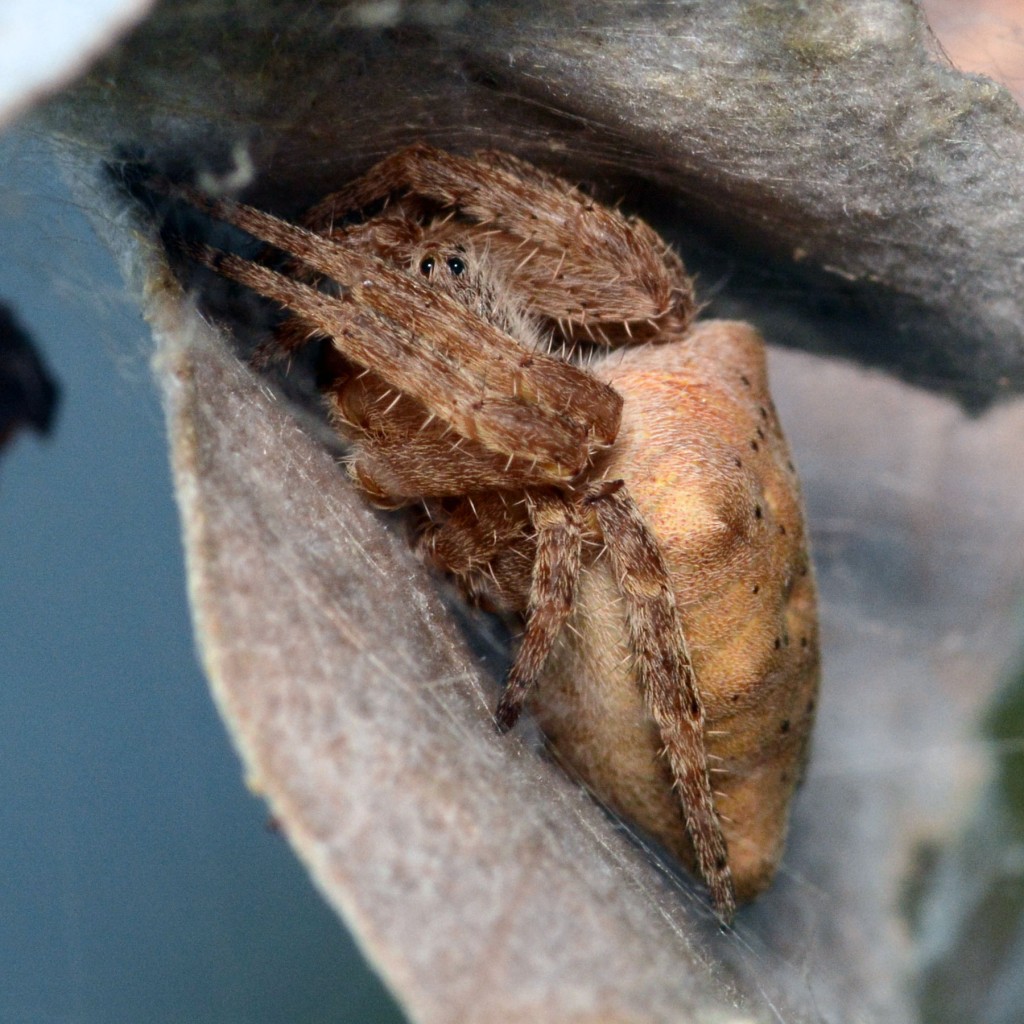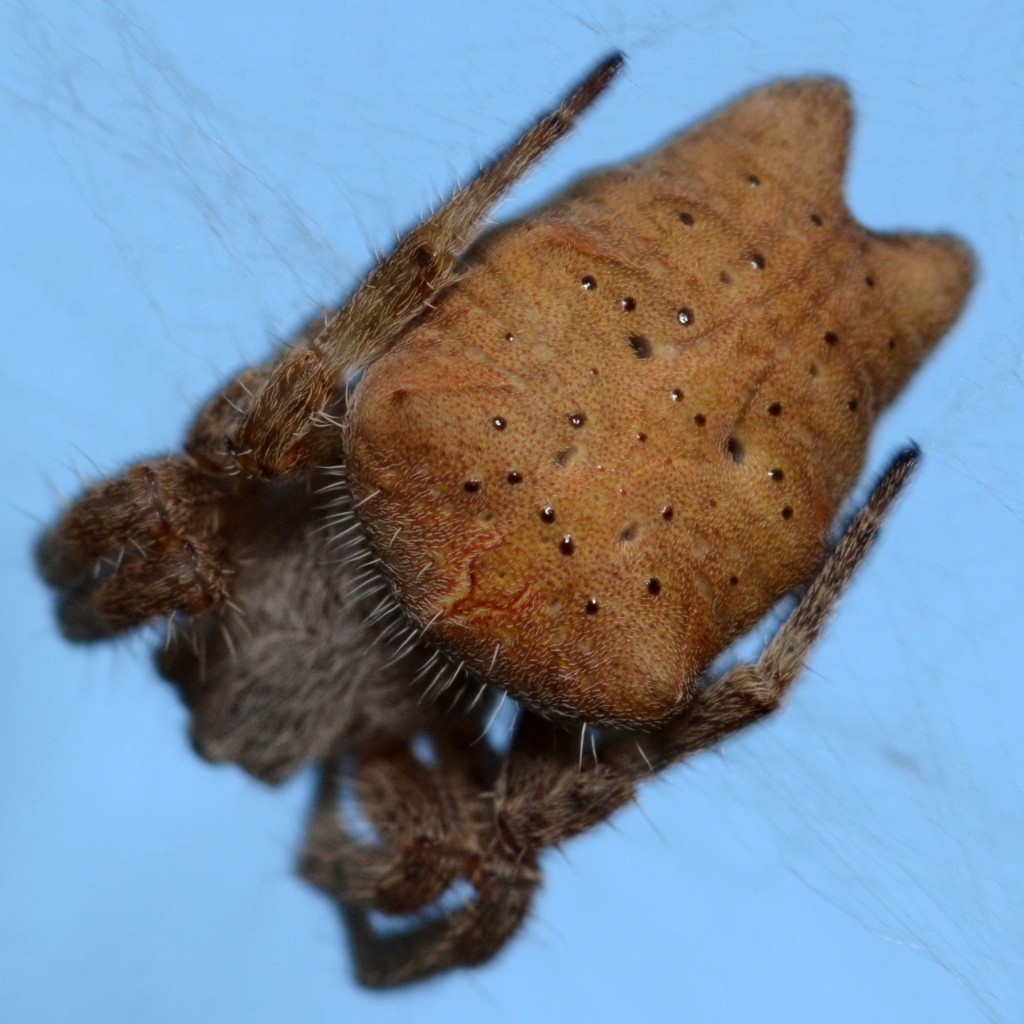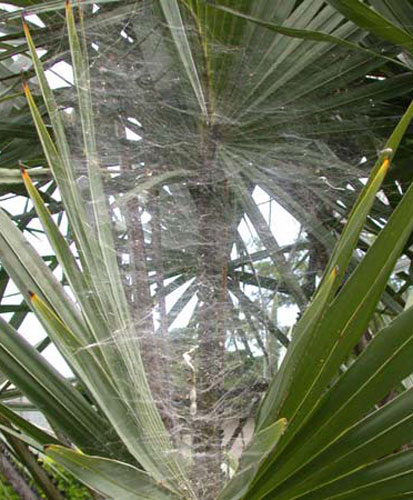Gardeners in south Florida are the inverse of the typical beachgoer: instead of looking forward to a sunny day for reading, we look forward to a cloudy morning for weeding! August days, even in the morning, can be brutal. Earlier this week my weather station reported a heat index of 110°F! So when we get rain overnight followed by lingering clouds, we jump at the chance to get a bit muddy while trimming back the overgrown foliage and pulling out the weeds from the flower beds.
When we get the chance to do this, we often discover new and unusual things, like this spider:

Here’s another view, where you can see the unusual shape of the abdomen:

The arrow-shaped posterior makes it look a bit like another spider I’d found in the past, the trashline orbweaver, but instead of being in a typical orb-shaped web, it was in the middle of the craziest web I’d ever seen, draped all over one of my small silver buttonwoods. The web was roughly spherical, but nowhere near as organized as a funnel web, and it was made of dry, not sticky, silk. Here’s a shot from the UF/IFAS featured creatures website—can you find the orb in that mess?

Turns out the web belongs to Cyrtophora citricola, a tropical tentweb orbweaver. This is an old world species introduced to Florida in the Miami area around this most recent turn of the century—at least, it was first written up in 2000; see summary by Edwards (2006).
Here is the first description of their arrival in Florida (Halbert 2000):
Cyrtophora n. sp., a spider: Several specimens have been collected in webs in Ficus benjamina at a nursery in Homestead (Miami-Dade County; E2000-545; Duraid I. Hanna; 2 March 2000, and E2000-965; Julieta Brambila;12 April 2000). Cyrtophora species are orbweaving spiders that make a lot of barrier webbing in addition to the orb. The barrier web tends to collect a lot of plant debris. The spiders appear to hide in or near the tip of a curled leaf and look like a piece of dead leaf or other detritus. The webs are about the dimension and volume of a basketball. If numerous, their webs could be conspicuous features in the landscape, and could possibly be considered a nuisance by some homeowners. NEW UNITED STATES RECORD.
These are interesting spiders, classed as orbweavers despite the fact that they produce a very large tent-like structure of nonsticky silk in addition to their horizontal rather than vertical orb-shaped web. (Most people encountering their crazy tentlike web have trouble even locating the orb in the middle of all that 3D craziness!) Here are some fun facts about these little critters:
- They are colonial, often establishing large living aggregations with dozens to scores of square meters of web; this large coverage enables them to overcome the disadvantage of nonsticky silk.
- They have rather oddly shaped bodies, with a trademark look to their rear end: a “horizontally oriented bifurcation at the posterior of the abdomen,” as Edwards (2006) puts it.
- Like Allocyclosa bifurca, the only other spider in Florida that it resembles in any way, shape, or form, C. citricola webs arrange eggs and detritus in a characteristic “trashline.” (I find it very interesting that the two “spiky orbweavers with bifurcated posteriors” in Florida share this behavioral trait in addition to their morphological similarity.)
Etymology
Cyrto– means humpback or hunchback; phor means thief, while phoras means fruitful, bearing. Not entirely sure which meaning Forsskål had in mind when he named the species in 1775 (posthumous publication arranged by his colleague Niebuhr). Citricola, it seems clear, is for the citrus trees where presumably the first specimens were found.
References
Edwards, G. B. 2006. Cyrtophora citricola (Araneae: Araneidae), a Colonial Tentweb Orbweaver Established in Florida. Entomology Circular No. 411 Fla. Dept. of Agriculture & Consumer Serv. Mar/Apr 2006 Division of Plant Industry.
Halbert SE. 2000. Arthropod Detection. Florida Department of Agriculture and Consumer Services, Division of Plant Industry, Tri-ology 39(2): 7.

We are in the nw corner of Nebraska. We have found this spider while painting our home. Never seen this spider before we are in an area where black widow spiders and wolf spiders rule the area.
Wow, I had no idea they’d adapt to northern climates like that. Weird!
Just found this little gem in a big messy web in the bottom branches of our Banyan tree. Never saw one before and I’ve been here for 35 years. My wife and i watched it kick out an unwanted wasp that had inadvertently flown into the web before hugging on a oval shaped egg and then finally hiding up under a leaf. It was a nice morning!